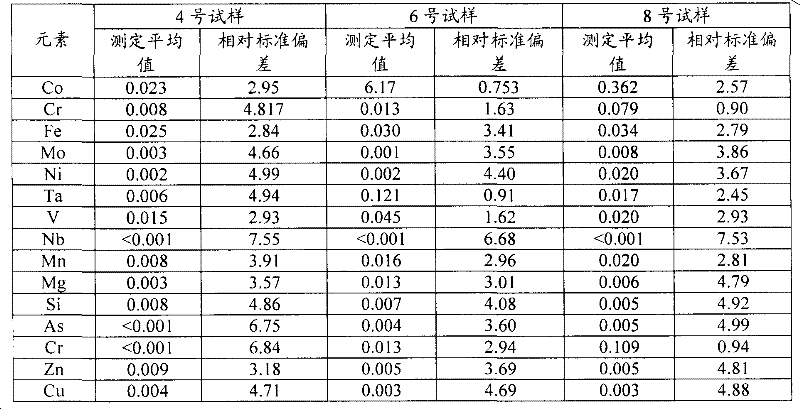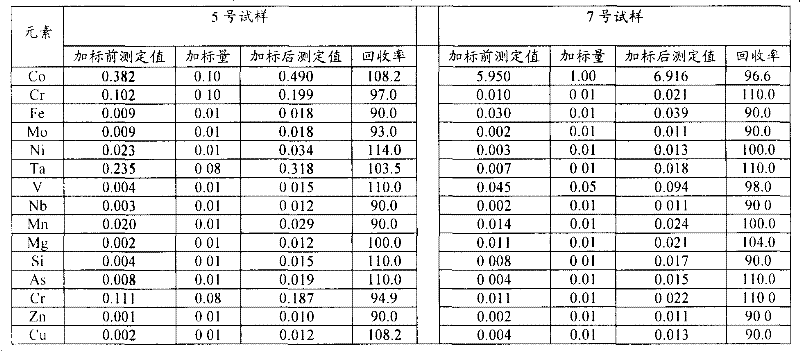Method of digesting, settling and separating tungsten-based samples and detection method for tungsten-based samples
A sedimentation separation and sample technology, which is applied in the preparation of test samples, measurement devices, analysis materials, etc., can solve the problems of cumbersome operation, long detection cycle, and ineffective washing of tungstic acid precipitation.
- Summary
- Abstract
- Description
- Claims
- Application Information
AI Technical Summary
Problems solved by technology
Method used
Image
Examples
preparation example Construction
[0018] The method of preparing a sample solution according to an embodiment of the present invention uses only nitric acid. More specifically, the method for preparing a sample solution according to an embodiment of the present invention is implemented in the existing HF-HNO 3 On the basis of the open digestion system of the electric heating plate, the use of hydrofluoric acid, the most critical sample digestion reagent in the original method, is abandoned, and a series of unfavorable factors caused by the introduction of hydrofluoric acid are avoided, such as corrosion of instruments, inability to use for the determination of element Si, and inaccurate test results. Accurate etc.
[0019] Due to the introduction of microwave technology, the present invention realizes rapid and complete digestion of samples such as tungsten carbide, metal tungsten, and hard alloy by only adding nitric acid under high-pressure airtightness and specific control parameters, and completely oxidize...
Embodiment 1
[0033] Digestion and sedimentation separation of metallic tungsten samples
[0034] Weigh 0.1000g tungsten powder sample (FWI-I, W>99.9%, produced by Zhuzhou Cemented Carbide Factory) (hereinafter referred to as sample No. 1) in the inner tank of microwave digestion, firstly along the wall of the inner tank to wash accurately Add 15.0mL of water quantitatively, and rinse all the samples that may be attached to the tank wall, and then add 4.0mL of concentrated nitric acid. Then put the outer jar on, close the lid and tighten it with a torque wrench to ensure a good seal. Put the sealed outer tank into the microwave digestion furnace according to the operation steps of the instrument, and connect the temperature and pressure sensors. Perform microwave digestion according to the set microwave digestion heating program. This embodiment adopts the microwave reaction method with three step steps to ramp up the temperature. The pressure is controlled below 800psi (1psi=6.895KPa). ...
Embodiment 2
[0039] The sample to be digested is 0.5000g tungsten powder sample (FWI-I, W>99.9%, produced by Zhuzhou Cemented Carbide Factory) (hereinafter referred to as No. 2 sample), add 25.0mL water and 10.0mL concentrated nitric acid, microwave program: 5min Raise the temperature to 190°C and hold it for 12 minutes; raise the temperature to 220°C for 2 minutes and hold it for 3 minutes; cool the solution to 105°C, restart the microwave for 1 minute and raise the temperature to 125°C and hold it for 5 minutes. Besides, the metal tungsten sample was digested in the same manner as in Example 1, and the supernatant was detected by ICP-AES.
PUM
 Login to View More
Login to View More Abstract
Description
Claims
Application Information
 Login to View More
Login to View More - R&D
- Intellectual Property
- Life Sciences
- Materials
- Tech Scout
- Unparalleled Data Quality
- Higher Quality Content
- 60% Fewer Hallucinations
Browse by: Latest US Patents, China's latest patents, Technical Efficacy Thesaurus, Application Domain, Technology Topic, Popular Technical Reports.
© 2025 PatSnap. All rights reserved.Legal|Privacy policy|Modern Slavery Act Transparency Statement|Sitemap|About US| Contact US: help@patsnap.com



